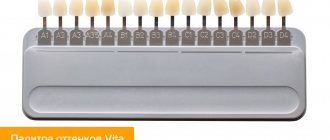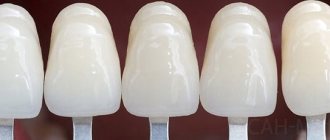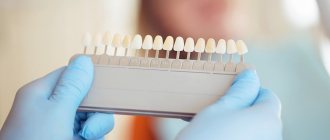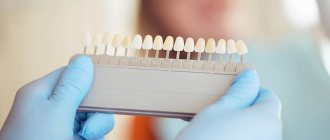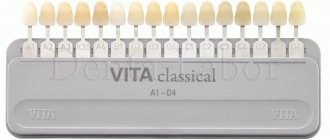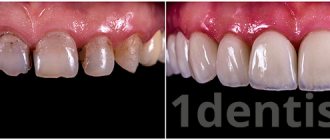Aesthetic dentistry is one of the most popular medical procedures, since in modern society white teeth are an indicator of health, success and youth. However, in reality this is not entirely true: healthy enamel has a slightly yellowish tint. Therefore, when selecting veneers, lumineers or filling material, as well as making crowns or preparing for whitening, it is important for the doctor to get into the individual color of the patient’s enamel. And the Vita scale for selecting teeth colors helps the doctor with this. What it is - the Vita scale, why and how it is used, as well as how it looks in the photo in comparison with natural teeth, you can find out from today's article.
Baby or primary teeth in children are usually whiter than permanent teeth in adults. This color comes from thinner enamel than permanent crowns. If the milk crowns have a yellowish or grayish tint, then this indicates their disease or a metabolic disorder in the body.
The method of returning the natural shade to temporary units depends on the reasons for its change. Sometimes it is enough to exclude certain foods from the diet and start filtering the water, and the color of the crowns will gradually be restored. If the change in enamel color is caused by a disease, then it is important to establish a diagnosis and select adequate treatment.
What color is considered normal for a milk bite?
Baby or primary teeth in children are usually whiter than permanent teeth in adults. This color comes from thinner enamel than permanent crowns. If the milk crowns have a yellowish or grayish tint, then this indicates their disease or a metabolic disorder in the body.
The method of returning the natural shade to temporary units depends on the reasons for its change. Sometimes it is enough to exclude certain foods from the diet and start filtering the water, and the color of the crowns will gradually be restored. If the change in enamel color is caused by a disease, then it is important to establish a diagnosis and select adequate treatment.
What healthy children's teeth should look like
Healthy baby teeth should be white and slightly translucent. Their formation begins in the sixth week of intrauterine development, and by the time the baby is born, all 20 rudiments should already be fully formed and waiting in the wings. Here, a lot depends on the woman’s health during pregnancy, so the expectant mother needs to carefully monitor her condition, eat right, treat emerging health problems in a timely manner, and, if possible, avoid taking potent medications.
Healthy baby teeth should be white and slightly translucent
So, for example, long-term use of tetracycline antibiotics during pregnancy leads to pronounced staining of the dental tissues of both mother and baby. As a result, the enamel acquires a rather bright yellow tint, which is very difficult to lighten.
Reasons for changes in enamel color in children
- Some diseases of a pregnant woman: viral or bacterial infections of the mother’s body, as well as some medications (for example, tetracycline antibiotics) leave an imprint on the development of the fetus, including the formation of its tooth buds. This is fraught with the fact that the baby will erupt in units already with a defect (enamel hypoplasia or hyperplasia, tetracycline teeth, etc.),
- initial stage of caries: may change the color of milk crowns (white spots appear on them),
- fluorosis: a surplus of fluoride in a child’s body (due to the large consumption of fluoride-containing products, water, the use of toothpaste with a high content of this element) changes the color of the enamel, it becomes grayer and at the same time rough, brittle, with grooves,
- treatment with iron preparations: if they are used in liquid form, they cause temporary darkening of the tooth surface,
- constant consumption of coloring products: blueberries, bird cherry, sweets and drinks with artificial colors or based on red and blue berries.
General presentation and purpose
This scale is presented in the form of a plastic tape onto which models of human teeth made of various materials (plastic, ceramics, porcelain, paper, etc.) are attached. This scale contains 16 different shades.
The Vita scale made from ceramics is considered to be the most accurate; it is this scale that allows you to most successfully select the shade when filling.
Today, no dentist will perform whitening without first comparing the initial and final results on the Vita scale. It is equipped with special retractable structures, which make it very convenient to compare the shades of hard-to-reach teeth.
In total, there are 4 main groups of tonality that the human eye can evaluate:
- Group A. These include teeth with a reddish-brown tint.
- Group B includes red-yellow shades.
- Group C – tones of gray.
- Group D - red-gray shade.
According to the degree of brightness, each group includes from 1 to 4 tones, which vary in increasing order from the lowest to the highest. That is, units with shade 4 will be the darkest in a room with natural lighting levels.
It is worth noting that the elements of the human jaw arch have different shades, depending on their location. Therefore, an experienced dentist will make comparisons at several points; only in this case can the most reliable result be obtained.
The Vita scale, made of paper or plastic, gives a less accurate result. It is best to use slats with ceramic or porcelain teeth examples.
What elements are included in popular chemical teeth whitening systems, and how often it is recommended to carry out the procedure.
Let's look at the pros and cons of whitening with the Bleach n Smile system here.
Reasons for changes in tooth shade in adults
- violation of the rules of brushing teeth at home: irregularity, unsuitable toothpaste or brush,
- hereditary reasons
- the richness of the daily menu with pigmented products: black berries, strong black and red tea, coffee without milk, red wine, ketchup, soy sauce, etc.,
- smoking: gives a yellow or even gray-yellow coating,
- With age, dentin darkens and enamel becomes thinner: therefore, crowns acquire a darker shade than in youth - due to translucent dentin. Thinning of the enamel due to metabolic disorders also leads to a change in the color of the unit, because dentin is naturally yellow,
- deficiency or surplus of certain vitamins or microelements: zinc, fluorine, iron in the body,
- the presence of an old filling: often its elements penetrate into the dentin over time, oxidize and color it gray or red, which affects the external shade,
- microrelief of the crown surface: the more pronounced it is (grooves, pits, roughness), the darker the crowns appear.
Attention! After professional teeth cleaning (without bleaching), crowns may become a shade or even two lighter. This happens because the hygienist removes plaque, which gives a darker color, grinds and polishes the teeth, leveling the microrelief.
Preventive measures
If over time your smile has yellowed, your teeth have become dull and stained, in some cases you can do without in-office whitening and veneers. To do this, it is enough to undergo a professional cleaning procedure in the dentist’s office and subsequently provide competent prevention:
- give up bad habits, reduce consumption of coffee, strong tea and coloring products,
- maintain a high level of hygiene, brush at least twice a day, rinse your mouth every time after eating, use floss,
- start treatment of emerging dental problems in a timely manner and undergo preventive examinations at least twice a year.
Using hygiene products will help preserve the color of the enamel.
If the cause of the darkening has more serious justifications, you will need to undergo a full diagnosis in order to identify the true causes of the problem and then work directly with them. Professional whitening, microprosthetics or installation of crowns/prostheses will help correct the aesthetic defect.
Scope of application of the Vita scale
Using a basic color chart, the dentist can identify the “native” shade of a person’s teeth or detect, if any, possible color defects. The fact is that the same tooth color looks different in people with different skin colors. For example, an unpleasant yellow tint is masked if a person returns from vacation very tanned, and then his smile appears white. However, the Vita scale helps to adequately assess the clinical picture. Such a tool is important in several dental fields.
The Vita scale is often used in the following situations:
- professional teeth cleaning with ultrasound and Air-flow: after ridding the patient of plaque, the hygienist must make sure that he has restored the natural color of the crowns. In addition, the Vita scale can be used before the procedure to conduct a comparative analysis of the effect of tartar on the color of crowns and to develop an individual oral care program for a particular person (this may include both nutritional correction and the cessation of bad habits, the use of certain brands of dental pastes and even brushes),
- for whitening in the clinic: laser, intracanal, photo bleaching, chemical bleaching. The doctor needs the palette to determine how many shades the enamel needs to be whitened, whether the result will look unnatural and whether it will lead to negative consequences, especially if the patient wants a snow-white smile, but the condition of his crowns does not allow him to achieve such a shade. In addition, during the procedure, the doctor should check the result so as not to overdo it,
- dental restoration: in the presence of chips, cracks and other surface defects, it is important that the filling, crown or microprosthesis are not noticeable on natural dental tissues.
Technique for determining color - how to choose the right shade
So, we found out that the Vita scale is used to determine what color a person’s teeth are and how to choose a shade during dentures or before lightening. But to correctly assess the condition of the enamel, the correct inspection technique is required. Below we will take a closer look at how the tone of teeth is determined and the shade closest to it is selected from the scale.
Preparing for a Smile Appearance Assessment
Before comparing enamel with the Vita palette, the patient must thoroughly clean his teeth of plaque and stone. However, more often than not this is not enough. Therefore, it is necessary to additionally carry out professional cleaning of dental plaque to restore the natural shade.
Before assessing color, you need to have your teeth professionally cleaned.
What factors influence color perception?
To properly assess tone, the inspection must be carried out under certain conditions. Thus, the results may be distorted due to incorrect lighting, poor quality of cleaning the enamel from plaque, the presence of foci of inflammation and other dental problems. Therefore, such diagnostics also require careful and attentive preparation.
Optimal conditions for the procedure
When answering the question of how to calculate how many shades your teeth have changed their color, you need to thoroughly clean them first. At the same time, fluorescent lamps must be installed in the dental office. The patient is advised not to wear bright clothes - it is better to give preference to calm pastel colors that will not create a sharp contrast.
The inspection must be carried out under certain conditions
How is the Vita scale used?
All the previously mentioned reasons must be taken into account by the dentist when a patient comes to him who needs treatment or cosmetic restoration of crowns. In all these cases, the doctor must focus on the natural appearance of the enamel in order to select the filling material of the desired shade or install veneers. For this, doctors use the Vita scale.
It is represented by a kind of palette, divided into quarters (sectors), designated by indices A, B, C and D. Each sector has several subtones, and thus the doctor has the ability to operate with 16 shades. This allows you to correctly correct the color during treatment or prosthetics. In addition, the patient himself can compare and choose the shade that seems most natural and acceptable to him.
Interesting! The Vita scale is usually made of laminated cardboard, plastic or thick paper, but professionals use a movable table with painted acrylic or ceramic overlays. This device is convenient to apply to the teeth, comparing and adjusting shades. The basic table produced by Ivoclar Vivadent (Liechtenstein) has good reviews from doctors all over the world. Its slats include the lightest shades (Bleach) of groups A, B, C and D. This palette costs 1,400 rubles.
In modern dentistry, all possible shades of enamel are usually divided into 4 groups:
- group A: reddish with a brownish bias, includes the five most popular shades - A1, A2, A3, A3.5 and A4,
- group B: red with a yellow bias. Includes 4 semitones from B1 to B4,
- group C: gray shades. This also includes 4 semitones - from C1 to C4,
- group D: red with a gray bias. Less common in our country, it has only three subtones - from D2 to D4, and D1 is absent altogether.
“The Vita scale is easy to use. Reusable, easy to apply due to the fact that it is laminated. I recommend purchasing this product for those who whiten their teeth at home. It will last a very long time."
Nastya, review from otzovik.com
What to do if your tooth color has changed
If a tooth suddenly darkens or acquires an uncharacteristic shade, it is probably due to pathological processes that require immediate help from specialists. You cannot delay with such a symptom - you need to contact a dentist as soon as possible so that he can assess the degree of deviation from the norm and diagnose the cause of the pathological phenomenon. A tooth can suddenly darken as a result of injury, the development of necrotic processes in the pulp area, or due to the presence of filling material containing silver, tin, mercury or zinc (obsolete materials).
Changes in enamel color indicate some pathological processes
If we talk about changing the color of the entire smile at once, then among the common prerequisites for the problem are work in the metallurgical industry, excessive consumption of coffee, strong tea, coloring products, smoking, taking powerful medications, and low levels of hygiene. In any case, such a situation requires increased attention and mandatory examination by a specialist. Even if it's all about poor hygiene or excessive coffee consumption, it's imperative to have a hygienic cleaning at the dentist's office. Otherwise, plaque will soon turn into hard deposits and become a prerequisite for the development of carious processes.
Tone selection features
To accurately determine which shade of the crown will be as close as possible to the natural color of the patient’s teeth, the doctor conducts a test using the Vita scale (see the visual photo below). According to the Vita determination rules, the dentist first selects which of the 4 groups the patient’s enamel color belongs to, and then within this group begins to select shades that most closely match the color of neighboring units.
How tone is assigned
The Vita subtone number is assigned based on the decrease in whiteness: the higher the number (or index), the darker the enamel color will be. For example, an overlay from the palette marked as A1 is the “whitest”, and A4 is the darkest of group A. And this rule applies to all groups.
2. Why high technology doesn’t always help
You can often read negative comments on forums that computer technology is not used to determine tone. And although there are programs developed specifically for such a procedure, the most accurate is still a visual comparison of the patient’s crowns with the base table.
Interesting to know! An adequate assessment of color by a computer is influenced by many factors: the lighting in which the image loaded into the program was taken, the resolution and color sensitivity of the camera used to take the image, and the color calibration of the computer itself. And even if at some point there was a failure of a tenth of a percent, this may affect the final result, and the sample selected by the computer will turn out to be lighter or darker than necessary.
In addition, using programs to determine the color of crowns is more expensive than using the basic Vita table, which is why doctors most often resort to this method, especially in small dental offices. And it’s more convenient for patients to compare samples in person.
3. What conditions are necessary for high-quality diagnostics
Despite the fact that using the Vita scale is cheaper and gives more accurate results, it is important to observe certain conditions when testing:
- Before testing, you need to brush your teeth twice: once at home, immediately before the appointment, and the second time the doctor cleans it using special solutions. This is necessary in order to remove microplaque that forms daily on the enamel and can affect its color,
- It is recommended that the patient come to the appointment wearing clothes in neutral pastel colors and with an open neck so that the fabric does not contrast with the face and teeth. If a person wears white, black or other bright clothing, this may distort the doctor's perception,
- In the dentist’s office, it is important to create high-quality lighting: if testing takes place in the dark, dentists use powerful lamps or special frames with LEDs to simulate daylight, which are held by the doctor’s assistant or the patient himself during testing. For the accuracy of the procedure, it is important to fully illuminate all crowns,
- the patient must be healthy: the choice of color tone according to the Vita scale, as a rule, is carried out only on healthy units of the dentition and in the absence of any chronic acute diseases in the patient. This is done because any serious disease of organs and systems can affect the natural color of crowns,
- if the patient has teeth with different shades of enamel: here the doctor often recommends an intermediate shade or a decision is made to correct not just one tooth, but the entire smile area.
Why and when is the scale used?
The Vita table is used in medicine to determine the naturalness of the tone, as well as the possible presence of a disease. If there is a significant difference from the norm, the doctor will provide appropriate treatment. In other words, the teeth tone scale is a kind of hint when examining a patient.
This auxiliary tool is not always used by dentists, but only in cases of need, when the patient plans to begin the whitening procedure, as well as treatment and straightening of a natural smile. The doctor may also need this tool when selecting and installing a ceramic implant.
How to maintain results for a long time
After dentures or whitening, it is very important to keep the color of your smile natural. To do this, it is important to follow the recommendations for caring for dentures (if artificial crowns or veneers were installed) or directly for the teeth (after the whitening procedure).
As a rule, the main stages of care are daily oral hygiene, exclusion from food (at least for the first weeks) of coloring foods - berries, wine, strong tea or coffee, as well as quitting smoking.
Good to know! Bleached enamel becomes thinner, and therefore more sensitive, so to care for it you need special gentle pastes and brushes with soft bristles. Doctors also advise rinsing your mouth after every meal and using floss for high-quality cleansing.
The same goes for veneers and ceramic inlays. For example, it is not recommended to use electric ultrasonic toothbrushes if you have such microprostheses, since the high frequency of rotation or vibration of the brush head can heat the prosthesis or peel off the adhesive, which leads to deformation of the prosthesis or a reduction in service life.
Do not forget to visit the dentist once every six months so that he can monitor the condition of the oral cavity and dentures, adjust hygiene procedures, and also diagnose the presence of diseases, in particular caries, in a timely manner.
Current promotions!
I WANT COLOR A1
Option 1. You are lucky - your teeth are like this by nature.
Take care of them! Regularly undergo comprehensive hygiene procedures and, if possible, try to limit dyes. But nothing lasts forever, and neither does the natural whiteness of teeth. Most likely, this will go away with age, unfortunately.
Option 2. Bleaching. There are several methods, they may have different names, the equipment used and the price, but the principle is the same - the chemical effect on the enamel with derivatives of hydrogen peroxide, with or without the use of a light lamp.
Is it effective? Yes, but under certain conditions: firstly, there should be no fillings or restorations on the front teeth, otherwise they will become noticeable after the whitening procedure and will need to be redone. Secondly, over time, the natural color will return, and bleaching must be repeated. After whitening, teeth can become very sensitive, so much so that repeating the procedure will be impossible. Repeated bleaching severely damages the enamel.
Option 3. Artistic restoration using composite materials. This method is applicable if your teeth are not ideally shaped and have natural wear. The doctor can use light-colored material, but all teeth that are visible when smiling and talking must undergo restoration. The advantages of this “build-up” are that the method is quite gentle, but the disadvantages are a large amount of expensive work and a shortage of specialists who are fluent in this technique. And of course, like everything else, restoration is not eternal.
Restoring lost color
If initially the patient’s teeth were much lighter and brighter, but over time they began to darken and lose their natural shade, you can try to do without expensive whitening and restore the color yourself. Typically, the following techniques give a good effect, provided they are used regularly:
- Quitting bad habits and, first of all, smoking.
- Maintain good oral hygiene, including brushing with fluoride-free whitening toothpastes and rinsing.
- Regular visits to the dentist and timely dental treatment.
- At least temporarily avoid drinks and foods with dyes, caffeine and fluoride.
We should not forget about prevention, which is recommended even if the normal color of tooth enamel is preserved. If all the efforts made were in vain and the smile is still far from ideal, you can resort to more radical measures.
As a rule, we are talking about professional services that include dental cleaning with the removal of stones and accumulated plaque, as well as external or intracanal whitening, which is most often carried out using special chemical solutions based on hydrogen peroxide. The latter procedure is indicated primarily for those patients who have suffered periodontitis (traumatic), and its main disadvantage is the increased sensitivity of the teeth.
If you want to make your teeth perfectly white for the long term, then it is better to resort to installing veneers, lumineers or ultraneers. It should be noted that, in addition to aesthetic indications, such manipulations are relevant for patients whose teeth have darkened due to regular use of medications or after the installation of artificial materials (fillings) that caused a change in color.
What is the relationship between enamel color and systemic diseases
Poor hygiene and dental diseases are not the only factors leading to darkening of the enamel. So, for example, such a nuisance can occur due to disruptions in fluoride metabolism in the body, with some systemic diseases and heavy metal poisoning. If we talk about dental pathologies, then fluorosis leads to the appearance of dark spots on the teeth, and the pulpless units completely darken from the inside.
Changes in the color of the enamel may indicate serious diseases of the body
If hard tissues have acquired a reddish tint, this may indicate internal disorders, such as rheumatism, porphyria, infectious pathologies: typhoid, cholera, dysentery. The condition of teeth also worsens with diabetes mellitus, as well as other disorders of the endocrine system.
Modern dental clinics offer all possibilities for correcting the shade of enamel: from professional and endodontic whitening to the installation of veneers or crowns. But it is better, of course, to initially maintain oral hygiene, monitor the health of your teeth and gums, and undergo regular preventive examinations with a dentist in order to protect yourself from many dental problems.
- Vavilyuk A A. Teeth whitening: what you need to pay attention to when choosing different systems, 2004.
